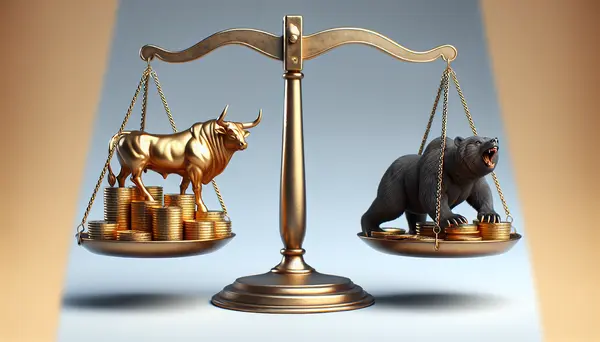- Line charts provide a simple visual representation of a security's price movement over a specific period of time.
- Bar charts offer more detailed information, showing opening, closing, high, and low prices for each period.
- Candlestick charts depict the same information as bar charts but with a more visual distinction between bullish and bearish periods.
Hey folks! Hope you all are having a profitable day. So here's what I'm thinking about - I've got around to understanding that making sense of charts seems to be a big part of trading, especially if you're into day trading, swing trading, or pretty much any kind that involves technical analysis. I'm getting it that they're crucial for trend recognition, right? So I'd love it if anyone could break down the different types of charts that traders use commonly and how they work. Like, I've heard about candlestick charts, line charts, bar charts, and so on, but I'm a bit fuzzy on the details. Appreciate any insights you can share with me on this.
You've got it right - charts are a trader's best friend! So, the most common types are line charts, bar charts, and candlestick charts.
Line charts are the simplest. They draw a line from one closing price to the next.
Bar charts show the opening and closing prices as well as the highs and lows. The bottom of the vertical bar shows the lowest price traded, and the top shows the highest. A small horizontal line on the left is the opening price, and one on the right is the closing price.
Candlestick charts are similar to bar charts but visually more informative. A thin line (or wick) shows the price range for the period, while a thicker body shows the range between opening and closing prices. If the body is filled (usually red or black), the closing price is lower than the opening price. An empty (or green/white) body signifies the opposite.
Each type suits different trading styles and strategies. Bar and candlestick charts provide more information and are typically used for short-term trading or detailed analysis. Line charts, with their simplicity, are better for general trends and long-term trading.
How is your chart-reading going? Need any extra tips on recognising patterns or setting up your chart for success?
Great explanation above! To expand on it, there are also a couple of other types of charts that traders could use.
One of them is the Point & Figure chart. This chart type tries to remove the insignificant price changes and focuses on the main trend direction. In Point & Figure charting, a column of Xs is used to illustrate a rising price, while Os represent a falling price.
Then we've got the Heikin Ashi charts which are very similar to candlestick charts, but they use a modified formula. The aim of Heikin Ashi is to filter out some of the market noise and provide a cleaner picture of the price action.
Another one to mention are the Kagi Charts - they ignore time and only change when prices reach a certain amount.
Each type of chart has its strengths and weaknesses so your choice really depends on your strategy and convenience. For example, Heikin Ashi charts could be useful if you find that you're getting spooked by the market noise in regular candlestick charts.
Apart from choosing the type of chart, there are also indicators and tools you can overlay on your charts like Moving Averages, RSI, Bollinger Bands etc. to help identify trends and signals according to your trading style. Have you started experimenting with any of these yet?
Honestly, those advanced charts can get overwhelming pretty quickly, especially for newbies. Just keep in mind they're tools, not crystal balls, and it still takes time to develop the intuition to trade effectively with them. Have you ever found yourself getting lost in the details and missing the bigger market picture?
Absolutely, one can get caught up in the minutiae. Ever tried using Renko charts to simplify the view and filter out minor price fluctuations, focusing on price movement more than time? How about integrating volume into chart analysis to gauge the strength behind price movements?
Definitely, integrating volume can be a game-changer. Curious to hear if anyone's been using On-Balance Volume (OBV) or Volume-price trend (VPT) as part of their toolkit? How's that working out for you in spotting those breakouts or reversals?
- How does the Producer Price Index (PPI) data impact the market? 8
- What tools can help me perform a fundamental analysis of a company? 2
- What are some trading platforms that allow for social trading/copy trading? 6
- Are there any tools that can help me with trading psychology and discipline? 2
- How do I deal with the fear of missing profits, or FOMP? 3
- Can you explain the concept of slippage in trading? 1
- How does seasonality impact market analysis? 4
- What is a securities' yield and how can it be analyzed? 5
- How do I use price charts for market analysis? 3
- Can anyone explain the principle of contrarian investing? 4
- How do you navigate the regulations surrounding short selling? 318
- What are Forex trading and its basics? 290
- How does seasonality impact market analysis? 252
- How do you manage stress during volatile market conditions? 217
- How does a stop-loss order work in trading? 205
- What tax implications should I consider when trading? 200
- What are the best platforms for online trading? 193
- What's the difference between day trading and long-term investing? 190
- What is swing trading and how is it different from day trading? 185
- How do you avoid letting past trading successes or failures impact your future decisions? 180

We have compared the best crypto exchanges for you. Just take a look at our free crypto exchange provider comparison.

We have compared the leading crypto tax tool providers for you. Check out our free crypto tax tool provider comparison.
Blog Posts | Current

Breaking Down the Buzzword: What is a Trading Bloc?
Are you familiar with the term "trading bloc"? It may sound complicated, but it's actually a concept that can have...

The Trader's Dilemma: Dealing with Losses in Trading
As a trader, losses are an inevitable part of the game. Even the most successful traders will experience losing trades...

From Chaos to Consistency: Why a Trading Setup is Key to Success
Trading is an exciting and rewarding way to make money, but it can also be overwhelming for beginners. One of...

Maximizing Returns: The Importance of Rebalancing Your Portfolio
Rebalancing your portfolio is an important part of any long-term investment strategy. It involves periodically adjusting your portfolio's asset allocation...

Different Cost Average Trading Strategies
Cost Average Trading is one of the most popular trading strategies used by investors to minimize their risk and maximize...

Don't Fall for the Hype: The Risks of Using Trading Bots
As a beginner trader, you may have come across the idea of using trading bots to automate your trading and...

Automating Your Trades: The Power of Trading Algorithms
As an avid trader, you've probably heard the buzz around trading algorithms. But what are they, and how can they...

Protect Your Capital with Effective Risk Management in Trading
Risk Management As a beginner trader, you're likely eager to dive into the markets and start making some profits. However, before...

The 5 most common mistakes made by crypto traders
The 5 most common mistakes made by crypto traders Crypto trading is becoming increasingly popular, but there is great potential to...

Mastering Your Mindset: The Key to Successful Trading Psychology
As a trader, your success in the markets depends not only on your technical skills and market knowledge, but also...
